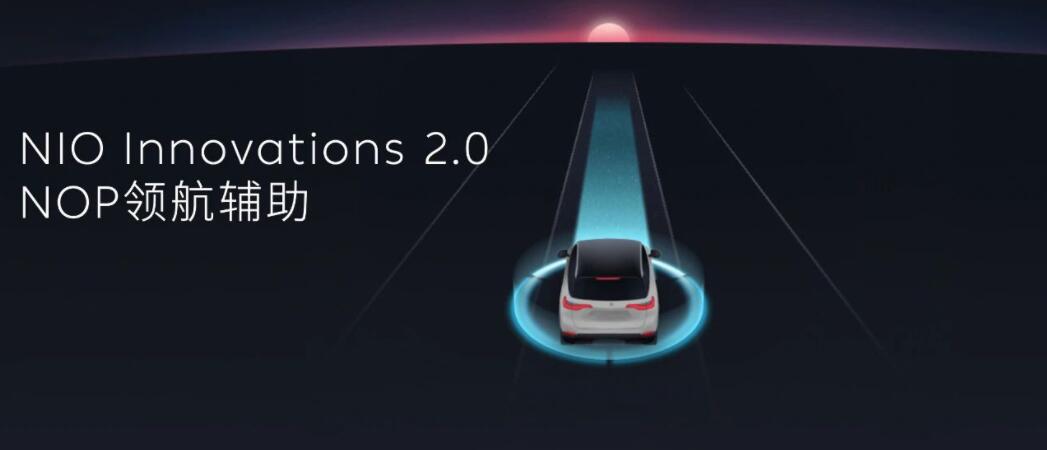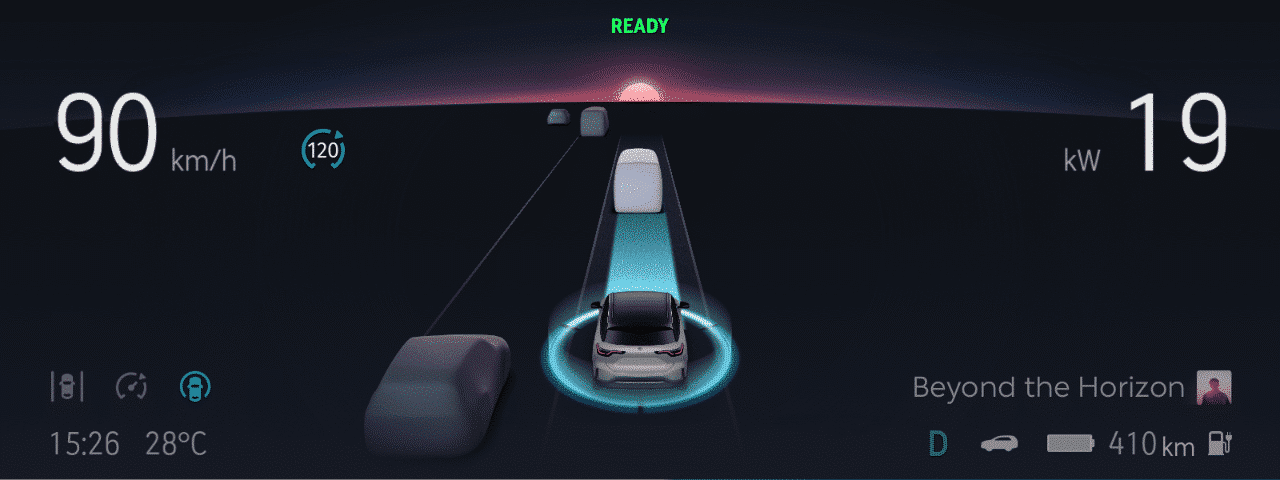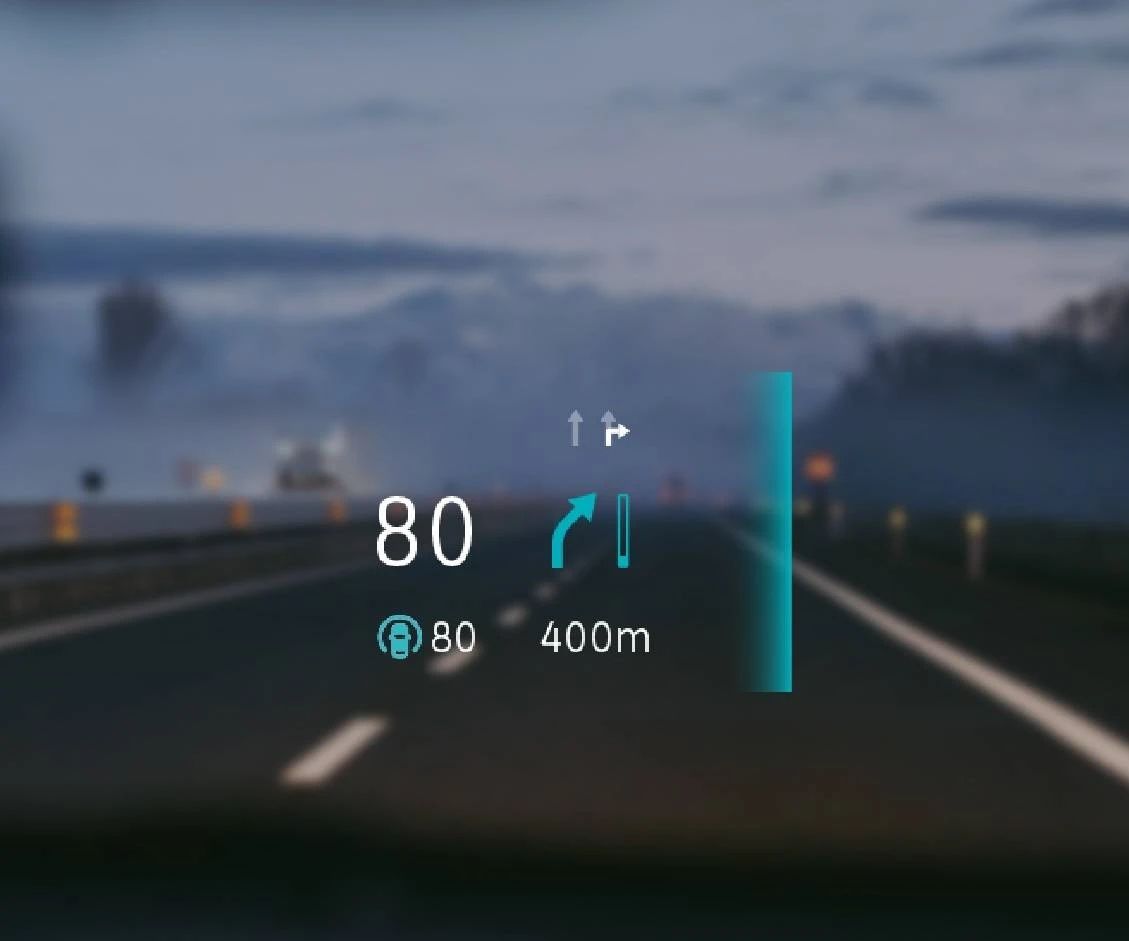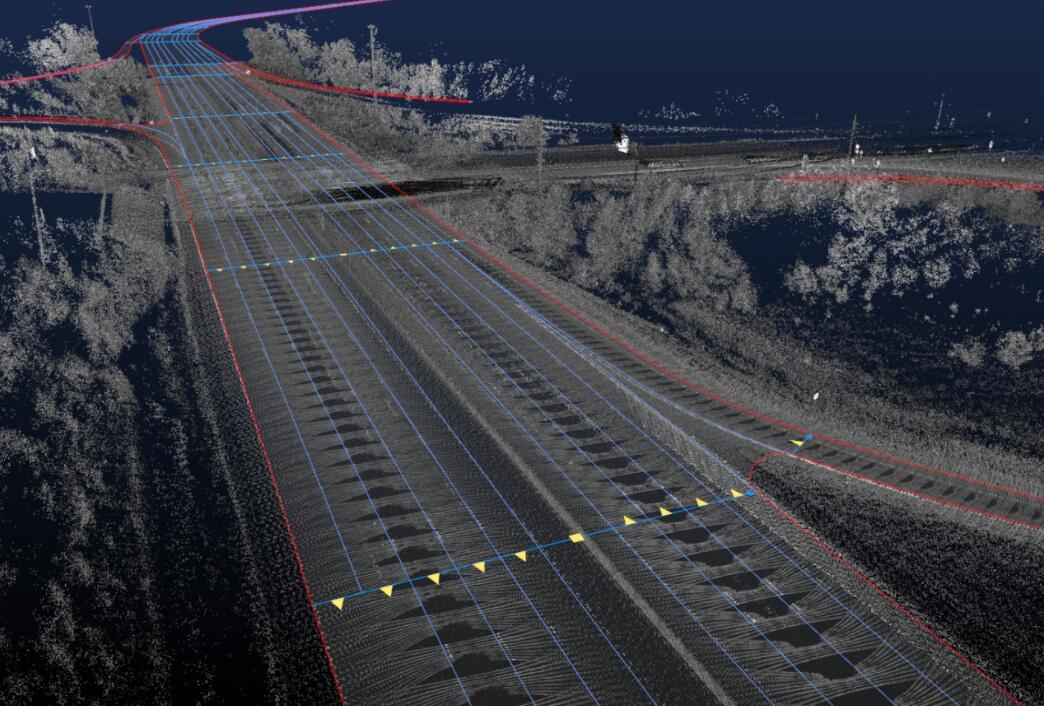In October 2018, Tesla pushed the NOA (Navigation on Autopilot) feature, unlocking advanced autopilot functions in highway conditions.
NOA mode, simply put, allows drivers to pre-input a start and endpoint on the car's navigation, confirm a navigation route, and have the vehicle automatically follow the route.
When the vehicle enters the freeway, the driver can activate NOA mode with a dial, at which point the vehicle can make and execute its own decisions, completing lane changes, acceleration and deceleration, merging, and entering and exiting ramp junctions.
Tesla's NOA mode can approach the level of autopilot in ideal highway conditions, which is very close to what the public perceives as autopilot capability - giving the vehicle a target and automatically reaching the destination without the need for the driver to take over the vehicle.
After Tesla spearheaded the NOA in its usual aggressive style, the real-world experience wasn't perfect, but as the only car company in the world to offer this feature, the NOA solidified Tesla's position as a leader in autopilot technology.
This position brought Tesla a large number of fans and endless room for imagination.
Now, this position of Tesla in the navigation-assisted driving market is going to be challenged.
On September 26, 2020, Nio CEO William Li Bin announced that the company will launch the Navigation On Pilot (NOP) feature, making Nio the second automotive brand in the world to implement this feature.
Taking a step forward from Tesla's NOA, Nio will enable the company's NOP feature not only on highways, but also on urban expressways in almost any city in the country (cities covered by high-precision maps).
The unlocking of urban elevated roads means that the pilot-assisted NOP mode is available on essentially all structured, closed roads.
The unlocking of these scenarios will significantly increase the usage of the NOP function, and car owners will be able to turn on the NOP for easier driving during their daily trips and weekday commutes.
The launch of Nio NOP breaks Tesla's dominance in the navigation assisted driving track, and will also bring additional competitive pressure to Chinese counterparts, forcing them to speed up the pace of entering the "Pilot Assisted Driving" track and triggering a new round of autopilot arms race.
1、Nio NOP debut
The difference between Nio NOP and mainstream L2 autopilot is that after successfully enabling NOP, the vehicle can make and execute autonomous decisions and execute vehicle lane changes, merging, entering and exiting highway and expressway ramp junctions without the need for the driver to toggle the steering paddle.
It will intelligently select the optimal lane and automatically switch to the next highway or elevated road according to the navigation plan and leave the main road automatically.
In addition, Nio NOP can achieve an intelligent speed limit and intelligent interaction experience compared to Tesla NOA.
Nio NOP is a qualitative improvement compared to the existing vehicles in terms of navigation assistance, and it can basically realize the setting of navigation in the coverage area, and then the vehicle can complete the driving task automatically under the supervision of the human driver.
With a high precision map, Nio NOP enables global route planning in advance and recommends the best path for the vehicle, so that the vehicle already knows exactly where it will change lanes before driving.
In normal mobile phone or car navigation mode, only the direction of travel at the current intersection is displayed. In unfamiliar roads, the driver needs to observe the navigation interface and listen to the navigation voice at any time.
On closed highways and urban expressways, the anxiety of making a wrong lane change on the wrong side of an intersection often results in a long detour and a lot of wasted time.
The point of global planning is to help ease the anxiety and tension of missing lane changes at intersections.
The NOP system can know in advance if a lane change is needed at the next intersection, what the next two kilometers are and what kind of road structure, and then decide when and where to choose a merging lane.
With the assistance of the NOP system, drivers don't have to worry about missing intersections all the time when the vehicle is driving normally. When approaching a junction for a lane change, the system will automatically make a lane change at the right time or remind the driver to prepare for a lane change.
When the vehicle is in pilot mode, it will automatically switch lanes according to the lane condition without any reminder from the user, which is an important sign of the intelligent change of the navigation assistance system and also distinguishes it from ordinary L2 automatic driving.
But the strategy of automatic lane changing is not quite the same as the calibration style of the Nio NOP and the Tesla NOA.
This difference comes partly from the different road and traffic conditions in different countries, as well as differences in driver behaviors and culture; and partly from the balance and trade-offs, companies make between technology, safety, and efficiency.
The Chinese road scene is particularly different. Some people are very aggressive and may change lanes while beating the lights, others are very conservative and barely change lanes, and everyone's driving style and expectations are different.
When changing lanes, Chinese traffic rules require three seconds after the lights are turned on before changing lanes, and if you follow this rule, it is impossible to change lanes on a busy road, and many people see the former's turn signal and speed up to overtake instead.
In response to this problem, Zhang Jianyong, head of Nio Autopilot, said that Nio's solution to the problem is to use a large amount of human driving data to train and infer a model that covers the majority of user scenarios.
In actual experience, Nio's NOP is more cautious and conservative than Tesla's NOA in terms of timing and action behavior, whether it's autonomous lane changing, merging or overtaking strategy.
The Nio NOP is more like a disciplined novice driver. After turning the turn signal to change lanes, he will take a few seconds to observe the lane change situation, and only change lanes when there is enough space before and after the lane change so that the car from behind will not approach, and the lane change is executed more gently.
With a more conservative calibration strategy, the NOP brings a more stable and comfortable ride.
However, it will be less efficient in lane change execution, and if the lane change side of the vehicle gap is small and traffic is heavy, it will be slow to complete the merge after the turn signal is on for a long time, which will alert the system that driver intervention is needed.
The Tesla NOA is like a more aggressive and horizontal older driver, with a very aggressive lane change style and a much lower requirement for lane change clearance. The lane change execution is crisper but less friendly to vehicles behind you.
In the experience of merging towards the ramp, the Nio NOP will change lanes towards the junction side about 2.5km earlier, while the Tesla will change lanes towards the junction side much later, sometimes only 500m from the junction.
The difference in style is felt more clearly in different scenarios.
In highway conditions with less traffic and better road conditions, the Nio NOP gives drivers ample time to mentally prepare without worrying about suddenly not being able to change lanes as they approach a junction.
But in traffic congestion, 2.5 km may make some older drivers feel too conservative and wait longer. The NOP system will advise the driver to take over manually. Obviously, a manual takeover is a more efficient option in heavy traffic conditions.
In terms of character, the Nio NOP is more like William Li Bin and the Tesla NOA is like Musk.
In response to Nio NOP's calibration style, Zhang Jianyong explained, "People will have a competition and game when overtaking and changing lanes, but for the assisted driving system, it can't actively create a competitive and gaming environment, it can only maintain a relatively safe and conservative strategy from a design point of view. “
In terms of practical experience, China's road conditions are indeed very complex, but in high traffic conditions, there is still room for improvement with Nio NOP's automatic lane change, and it's worth continuing to think about and optimize how to balance safety and efficiency.
The Nio NOP system, after entering the pilot assisted driving state, can automatically adjust the speed limit according to different scenarios, unlike the current ACC system of L2 autopilot, which has only one speed limit and needs to be constantly adjusted manually.
Compared to the Tesla NOA, the Nio NOP is more comprehensive and intelligent in its speed limit control.
The difficulty with speed limits is that they come from a variety of sources, both at the level of road regulations and from the driver's personal feelings.
When the Nio NOP system enters the main road, the vehicle will automatically set the cruising speed according to the road speed limit and high precision map information and select the optimal lane to drive intelligently based on the road conditions.
When driving normally in the lane, the NOP system will try to keep the vehicle in the leftmost lane with the maximum speed limit to improve efficiency without speeding.
Thanks to the high precision map come with speed limit information, as well as the curvature and slope of the road, fused with road regulations, the camera information NOP can control the speed of the lane in advance, which is more obvious when entering and leaving the ramp.
The Tesla NOA early on gives the impression that it will scramble when entering the ramp. It is very aggressive in speed control, sometimes rushing into the ramp entrance quickly, and then braking hard in the ramp to reduce speed after getting speed limit instruction.
With the introduction of Nio NOP's high-precision map, vehicles can anticipate all the speed limits, ramp curvature, and slope, and intersection angle information in advance, so that when entering the ramp, the speed control is softer and more reasonable.
In terms of real-world experience, the Nio NOP was able to control the speed of the vehicle once it entered the ramp at around 60 mph in normal traffic flow, which is a relatively balanced speed for driving feel and safety.
Of course, Zhang Jianyong reminds us that due to the limitation of the high-precision map, NOP can't do the exact speed limit at lane level, but only refer to the maximum speed between lanes on the same road.
In addition, NOP can't get information about the temporary speed limit due to weather or road construction. When cruising along, drivers should still pay attention to the actual conditions of the current road to avoid speeding.
One of the highlights of the Nio NOP is the intelligent interaction experience.
Neither Nio's NOP nor Tesla's NOA is currently a true L3 level autopilot system.
The person responsible for a vehicle accident is still the driver, who needs to be aware of the vehicle's status at all times and needs to be ready to take over the vehicle at any time when exiting cruise mode.
Therefore, in the pilot mode, the display of the vehicle cruise information and communication between the human-machine is very important, especially when the pilot mode is disengaged, if the driver can not get the information in time to take over, it is likely to cause a tragedy.
Nio's approach to human-computer interaction, especially the "take over the problem", is more comprehensive and user-friendly than Tesla's. Nio ES8 has a more comprehensive and user-friendly approach to navigation system settings.
Nio ES8 will automatically identify if the current road is suitable for opening NOP by pressing the cruise button on the left side of the steering wheel after the navigation system is set in pilot mode, if the current road meets the requirement, NOP will be opened automatically, if not, it will be downgraded to Nio Pilot.
After NOP is successfully activated, the system will share and remind information in the dashboard, HUD projection and voice interaction.
NOP will display the blue pilot logo and blue skyline on the dashboard and HUD, and NOP will display the blue pillar on the dashboard and HUD on the corresponding lane side when changing lanes and merging lanes.
At the voice interaction level, NOMI is broadcast simultaneously during automatic lane changes, entry and exit ramps, and before the NOP exits and needs to take over, reducing the risk of losing control of the vehicle.
Tesla will have little to no voice communication with the driver when NOA is on.
And Tesla's approach to alerting the driver when NOA is disengaged is also very risky, not only is there no voice alert, its text alert on the dashboard is located at the very bottom of the dashboard, an area that can easily be blocked by the steering wheel in the real-world driving experience, preventing the owner from receiving the takeover message in a timely manner.
To prevent driver distraction in long lead mode, the Nio NOP also incorporates the DMS Driver Attention Monitoring System, which will remind the driver to concentrate via voice and other means if it detects that the driver's eyes are off the road for an extended period of time.
However, on calibration, the DMS has a low tolerance for drivers looking left and right in the rearview mirror, and looking in the rearview mirror for more than a few seconds triggers a reminder when changing lanes and merging, which can sometimes be distracting when traffic is heavy and lane changes are difficult. There is room for optimization intolerance and decision logic.
Nio plans to push the latest Nio OS 2.7.0 version to users on October 10, 2020, in batches for ES6, ES8, and EC6 vehicles that are currently version 2.6.0 and above, pushing the NOP functionality to users.
It is worth mentioning that every Nio vehicle owner can support the NOP function upgrade in their hardware system.
2. Self-driving in China
The Nio NOP system spreads the application scenario to the expressway, which can help drivers relieve driving anxiety and fatigue in more scenarios.
In terms of intelligent experience, Nio plays to the strengths of the interaction experience, human-machine information, and take over communication is more convenient and humane.
China is recognized as one of the most unfriendly places for automated driving systems, and any system that works well in the U.S. or Europe will need to start "learning" again when it comes to China.
The Nio NOP surpasses the Tesla NOA in some aspects of the driving experience for three main reasons.
Localized optimization for Chinese roads is another key feature of Nio NOP, which is also an advantage for Chinese brands.
In addition to the information provided by high precision maps, Nio has done a lot of localized performance optimization and verification for Chinese roads and scenarios.
According to Zhang Jianyong, the total mileage of Nio Pilot has exceeded 2 million kilometers and the total mileage of NOP is nearly 300,000 kilometers.
In addition, during the road test, Nio has marked all special scenarios, and the number of scenarios has now exceeded 32,300. More than 30 key cities in the country to do test coverage, Shanghai has now more than 10,000, the entire test software iteration 43 times.
For example, ramp access system. There are many ramp scenarios in China, and the direction of the ramp and the main road, splitting and merging width and even marking lines are all very different.
For China's complex ramp system, Zhang Jianyong said that the NOP's goal is to keep the speed relatively flat and down, but also to keep the entire vehicle under control, such as not hitting the steering wheel too hard.
In addition, when driving normally, slow cars often occupy the fast lane for a long time on Chinese roads, and NOP finds slow cars in the fast lane for a long time, NOP will also choose to change lanes from the right.
In contrast, Tesla's local development and optimization for the Chinese market is still far from enough, and the autopilot system based on the US local environment needs to do a lot of localization work to adapt to the Chinese roads and driving culture.
In terms of hardware, Nio's configuration is more comprehensive, with multiple redundancies in the hardware.
The NOP hardware specifically includes one Mobileye EyeQ4 processor, one forward triple-view camera, four surround-view cameras, five millimeter-wave radars, 12 ultrasonic radars, and one driver monitoring camera.
The perceptual combination of 7 external cameras and 5 millimeter-wave radars allows the Nio to achieve 360° heterogeneous surround-view perception redundancy.
The Nio NOP is more robust in terms of perception compared to the pure vision solution of the Tesla NOA.
Tesla's NOA system currently has a blind spot on the left and right front side due to the absence of millimeter-wave radar, with only one millimeter-wave radar directly in front of working with the camera.
In China, where traffic congestion is frequent, the Tesla vehicle will run head-on into the congested vehicle.
In addition, Tesla NOA's perception of oncoming traffic to the side when merging into the main lane at some ramps is also flawed, making it prone to collisions.
High-precision maps are a killer feature of China's local autopilot system.
Musk hopes to solve the problem of autopilot through a pure perception solution without the support of high-precision maps, but also has no choice but to have a hard time.
Because maps, especially high-precision maps, involve eligibility issues, Tesla, as a global automaker, needs to address the above issues in each country, which is very costly.
High-precision maps will, in time, become a uniquely competitive tool for local Chinese car companies and Tesla in the autopilot competition.
The accuracy of the mobile phone navigation used in daily life can only be controlled at the meter level. Due to the low accuracy, it is sometimes difficult for mobile phone navigation to identify main roads, secondary roads, and viaducts.
High-precision maps store a large amount of driving assistance information as structured data, mainly including road data, such as lane line location, type, width, slope, and curvature of the lane information.
It also involves information about fixed objects around the lane, such as traffic signs, traffic signals, and other information, lane height limits, sewer crossings, obstacles, and other road details, as well as infrastructure information such as elevated objects, guardrails, number, road edge types, and roadside landmarks.
High-precision maps provide automated vehicles with over-the-horizon information about road conditions and help them make speed and direction control decisions, acting as the vehicle's "eyes in the sky" and enabling "God's eye" mode.
At the same time, tricamera onboard monitors the road markings ahead and identifies the lane it is in, similar to the human eye determining which lane it is in.
The combination of high-precision mapping, vehicle positioning, and the "relative position" of the onboard detector allows the Nio to locate the vehicle on the road with an accuracy of 20 centimeters.
The introduction and integration of high-precision maps is an important reason why Nio Pilot is able to achieve NOP functionality, especially in urban expressway scenarios.
3. Automated Driving Arms Race
Zhang Jianyong said Nio's autopilot team has more than 150 people, mainly working in Shanghai.
The advantage of setting up a team by itself is that it can control the core technology and optimize the driving experience, while at the same time enabling rapid iteration of features and pushing them to users in a timely manner through OTA.
According to the data released by Nio, the Nio Pilot automatic driving assistance system has already implemented more than 20 automatic driving assistance functions, with more than 50% of the users having installed the Nio Pilot function and driving a total of more than 70 million kilometers.
Up to now, Nio has upgraded Nio Pilot 8 times via FOTA, covering a total of 23 new and optimized functions.
In Nio Pilot, cruise speed control, distance keeping, steering assist and turn signal control for lane change have been realized.
According to Zhang Jianyong, the development of NOP took 1.5 years from project inception to final delivery.
Nio NOP is just the beginning.
On September 2, 2020, Nio made an announcement to the public that the company had once again raised $1.956 billion in the open market.
This funding was used to develop Autopilot which became the main priority.
On August 14, it was revealed that Ren Shaoqing, formerly CTO of automated driving startup Momenta, had joined Nio as an assistant vice president, Ren Shaoqing is an expert in the field of machine vision.
According to media reports, Nio is currently recruiting top talent for its automated driving program.
Nio Capital, which was founded by William Li Bin, has a broad footprint in the field of automated driving, with investments in solution companies Momenta, Pony.ai, Inceptio Technology, Trunk, LIDAR company Innovision and AI chip company Black Sesame Technologies.
William Li Bin has said that L4 level autonomy will be implemented on the next generation driving platform.
At this point, the landing of the Nio NOP will put competitive pressure on local competitors.
The pilot-assisted driving experience, relative to the current L2, has really improved massively.
Although this system has one or another problem in the current period, the experience will get better and better as a large number of users upgrade to the system and a large amount of user usage data comes up, allowing for rapid iteration of features.
This will force products like the Xpeng P7 and Li ONE to increase their R&D efforts in the field of pilot-assisted driving.
On the other hand, Tesla will also be a huge "spur", in the field of automated driving, Tesla is gradually leaving the era of the dustbin.
Although the company still has a huge advantage in the architecture, system, chip, but in the user end of the feeling advantage is no longer obvious, and in some places even at a disadvantage.
When you are no longer the only player in this market, you need to make the system even more extreme.
And, of course, the moment of choice has come for traditional automakers, and the autopilot strategy is not an optional one, but a life-or-death strategy.
In order to be a viable automaker, you have to master the autopilot system.
For the L4 Autopilot battle, competitiveness is reliability.
For any company, there is only one way to improve reliability - and that is to continually verify it with data, and the L4 autopilot battle will eventually converge technologically and the core competition will gradually return to data scale, which is essentially the fleet size.
That's where Nio comes in, and as of today, the company has the largest fleet of smart EVs with navigation-assisted driving capabilities in China other than Tesla.
On October 2, 2020, Nio announced that it had delivered a total of 4,708 smart EVs in September, for a total of 26,375 deliveries from January-September 2020, for an overall EV fleet of 58,288 vehicles, a figure much higher than that of its new powerhouse competitors in China.
If the Nio can defend its sales advantage, it will largely be able to defend its lead in automated driving as well.
The launch of Nio NOP will truly bring the mass production of autonomous driving systems into the era of "Pilot Assisted Driving”.
At the same time, an even larger "arms race" to L4 level autopilot is already underway.




